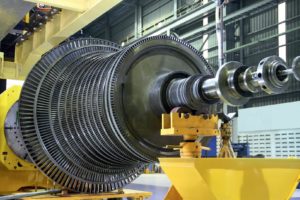Excerpt from “Selective Brilliance: The Use of Brush Plating in the PowerGen Industry,” a whitepaper.
The majority of industrial and municipal electric power production in the US is produced by generators driven by steam or gas turbines, with a substantially smaller percentage being produced by wind turbines. At its core, a turbine consists essentially of a series of rotating blades, the normal mechanics of rotating equipment is one of the factors contributing to a variety of maintenance challenges.
Some problems are more common in gas turbines where corrosion of high-strength, high-cost forged steel components can take place over time. Corrosion may attack turbine shafting or other components in critical areas and, eventually, weaken a shaft. Within a turbine, corrosion and the subsequent erosion of metal results in what is termed ‘bucket rock’. This occurs because the blades within the turbine are not perfectly balanced until the turbine is running at full RPM. So, when a turbine starts up or shuts down the blades rock back and forth until full speed or complete halt is achieved. This rocking causes scraping and rubbing on the shaft, wearing down the metal and creating an area referred to as a bucket – an out-of-tolerance clearance between areas of the shaft and blades. Peak-load GenSets, distributed generating systems located in proximity to the end user, are particularly subject to additional stresses due to the frequency of cycling from on-line to off-line service. During the off-line periods of low-speed turning-gear rotation, the bucket rock wear problem occurs due to impact and erosion of precision bucket fit-to-wheel tolerances.
Other factors affecting both turbines and generators are high heat and on-going corrosion. Wear or scoring damage can occur on bearing journals or shaft seal areas due to poor lubrication, contamination or overheating. Various atmospheric contaminants and the galvanic potential of dissimilar metals may cause corrosion problems which can often be accelerated by heat, or a variety of fraying surfaces.
According to a report from consultancy firm GlobalData, global maintenance expenditure is expected to rise from $9.25bn in 2014 to $17bn in 2020, growth driven by increasing numbers of installations and ageing turbines.
Selective plating is one way to deliver anti-corrosion properties and protect against wear and friction. It can help protect, enhance and optimize the performance of critical components and equipment and can help to improve operating performance, life expectancy, reliability and total cost of ownership.
For the OEM, generators pose a range of unique challenges in design, production and maintenance as bus bar connections carry huge current loads and the conductivity and long-term integrity of these connections is essential to output efficiency. Copper and aluminum conductors and other critical grounding locations are commonly electroplated with silver or tin and, in certain applications, nickel.
Dynamic joints, which are subject to fretting, may also be candidates for special electroplating processes, particularly when dissimilar metals and galvanic potential are considered in design. Heat sinks present a different set of challenges and, depending on geometry, specific areas of the heat sink may best be electroplated with silver, tin or nickel while the balance of the surface area remains bare or has paint-type coatings applied.
Other areas where electroplating provides an effective solution are collector rings and exciter components that may have design requirements where electroplated components or specific surfaces of the component will require enhanced conductivity and extend service life. Generator retaining ring inside diameters and the shrink-fit mating area on the rotor/field forging often require enhanced surface treatments to ensure the long-term integrity of the electrical joint, current capacity and proper-fit dimensions.
There is a variety of methods commonly used for mechanical tolerance re-builds and the improvement and protection of current-carrying surfaces, some of which include weld overlay, metal/thermal spray, and plasticized metals powders, and off-site immersion tank plating. While all have their niches, none offer the distinct advantages of selective plating.
Significantly faster than tank plating, selective plating minimizes masking, disassembly and downtime, depositing solutions that resist wear, electrical contact and corrosion. It is fast and cost-effective and adaptable for everything from OEM product application to one-off repairs and can be carried out on-site, anywhere.

 Chinese (Simplified)
Chinese (Simplified)  English (UK)
English (UK)  French
French  German
German  Spanish
Spanish  Swedish
Swedish 

